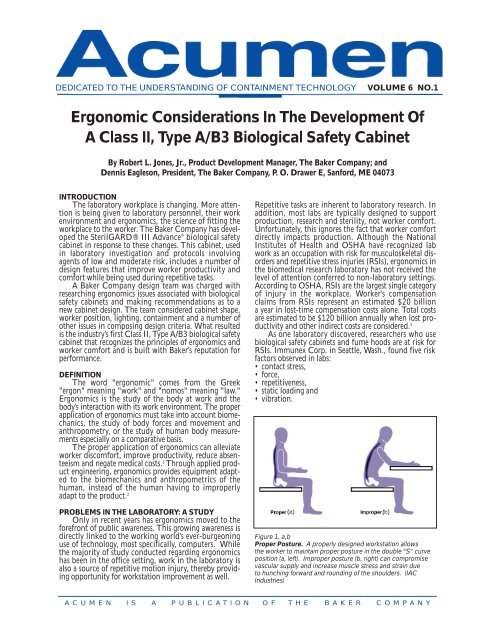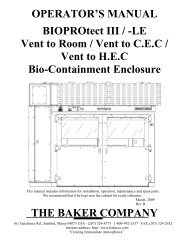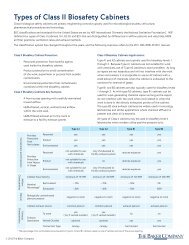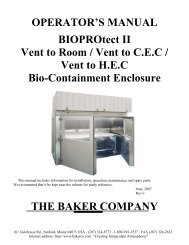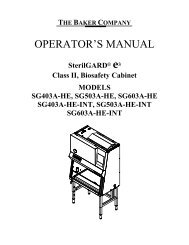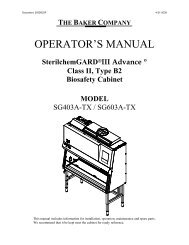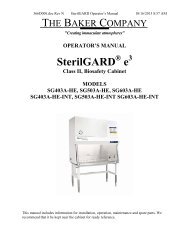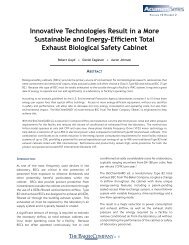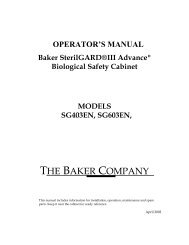Ergonomic Considerations In The Development Of ... - Baker Company
Ergonomic Considerations In The Development Of ... - Baker Company
Ergonomic Considerations In The Development Of ... - Baker Company
You also want an ePaper? Increase the reach of your titles
YUMPU automatically turns print PDFs into web optimized ePapers that Google loves.
DEDICATED TO THE UNDERSTANDING OF CONTAINMENT TECHNOLOGYVOLUME 6 NO.1<strong>Ergonomic</strong> <strong>Considerations</strong> <strong>In</strong> <strong>The</strong> <strong>Development</strong> <strong>Of</strong>A Class II, Type A/B3 Biological Safety CabinetBy Robert L. Jones, Jr., Product <strong>Development</strong> Manager, <strong>The</strong> <strong>Baker</strong> <strong>Company</strong>; andDennis Eagleson, President, <strong>The</strong> <strong>Baker</strong> <strong>Company</strong>, P. O. Drawer E, Sanford, ME 04073INTRODUCTION<strong>The</strong> laboratory workplace is changing. More attentionis being given to laboratory personnel, their workenvironment and ergonomics, the science of fitting theworkplace to the worker. <strong>The</strong> <strong>Baker</strong> <strong>Company</strong> has developedthe SterilGARD® III Advance° biological safetycabinet in response to these changes. This cabinet, usedin laboratory investigation and protocols involvingagents of low and moderate risk, includes a number ofdesign features that improve worker productivity andcomfort while being used during repetitive tasks.A <strong>Baker</strong> <strong>Company</strong> design team was charged withresearching ergonomics issues associated with biologicalsafety cabinets and making recommendations as to anew cabinet design. <strong>The</strong> team considered cabinet shape,worker position, lighting, containment and a number ofother issues in composing design criteria. What resultedis the industry’s first Class II, Type A/B3 biological safetycabinet that recognizes the principles of ergonomics andworker comfort and is built with <strong>Baker</strong>’s reputation forperformance.DEFINITION<strong>The</strong> word "ergonomic" comes from the Greek"ergon" meaning "work" and "nomos" meaning "law."<strong>Ergonomic</strong>s is the study of the body at work and thebody’s interaction with its work environment. <strong>The</strong> properapplication of ergonomics must take into account biomechanics,the study of body forces and movement andanthropometry, or the study of human body measurementsespecially on a comparative basis.<strong>The</strong> proper application of ergonomics can alleviateworker discomfort, improve productivity, reduce absenteeismand negate medical costs. 1 Through applied productengineering, ergonomics provides equipment adaptedto the biomechanics and anthropometrics of thehuman, instead of the human having to improperlyadapt to the product. 2PROBLEMS IN THE LABORATORY: A STUDYOnly in recent years has ergonomics moved to theforefront of public awareness. This growing awareness isdirectly linked to the working world’s ever-burgeoninguse of technology, most specifically, computers. Whilethe majority of study conducted regarding ergonomicshas been in the office setting, work in the laboratory isalso a source of repetitive motion injury, thereby providingopportunity for workstation improvement as well.Repetitive tasks are inherent to laboratory research. <strong>In</strong>addition, most labs are typically designed to supportproduction, research and sterility, not worker comfort.Unfortunately, this ignores the fact that worker comfortdirectly impacts production. Although the National<strong>In</strong>stitutes of Health and OSHA have recognized labwork as an occupation with risk for musculoskeletal disordersand repetitive stress injuries (RSIs), ergonomics inthe biomedical research laboratory has not received thelevel of attention conferred to non-laboratory settings.According to OSHA, RSIs are the largest single categoryof injury in the workplace. Worker’s compensationclaims from RSIs represent an estimated $20 billiona year in lost-time compensation costs alone. Total costsare estimated to be $120 billion annually when lost productivityand other indirect costs are considered. 3As one laboratory discovered, researchers who usebiological safety cabinets and fume hoods are at risk forRSIs. Immunex Corp. in Seattle, Wash., found five riskfactors observed in labs:• contact stress,• force,• repetitiveness,• static loading and• vibration.Figure 1, a,bProper Posture. A properly designed workstation allowsthe worker to maintain proper posture in the double "S" curveposition (a, left). Improper posture (b, right) can compromisevascular supply and increase muscle stress and strain dueto hunching forward and rounding of the shoulders. (IAC<strong>In</strong>dustries)ACUMEN IS A PUBLICATION OF THE BAKER COMPANY
Poor posture and positioning were the most commonproblem observed. Work at the biosafety cabinetsrequired researchers to hold their heads and arms in aforward position with shoulders rounded forward. Sucha static posture can compromise the vascular supply,compress nerves in the arms and increase muscle stressand strain. This hunched-forward position, compromisingthe ideal "double S" curve of the spine, is furtherexaggerated when the feet are placed on the ring-stylefootrest common to many lab stools. Proper posture isthe "neutral" position, or the position that requires theleast amount of muscle force and allows maximum roomfor blood flow. This proper posture should be: ears overshoulders, shoulders in line with hips, forearms 90degrees or more from the upper arms and wrists in neutralposition. 4Immunex found that the use of an industrial-heightfootstool allows technicians to achieve the best possibleposture and position at the static biological safety cabinet.<strong>The</strong> footstool allows the user to plant his feet firmlyin front to give a solid, three-point base of support.Providing an adjustable lab stool with enhanced lumbarsupport was also an important improvement. This styleof lab stool provides employees working in a forwardposition (such as at a biosafety cabinet) with needed supportduring rest periods. 5THE BAKER DESIGN PREMISEConscious of problems in the laboratory, the <strong>Baker</strong><strong>Company</strong> design team conducted its own research whendeveloping the SterilGARD® III Advance°, surveyinglab workers and ergonomics experts including WilliamH. Moore, Ph.D., Professor of <strong>Ergonomic</strong>s, Universityof Southern Maine. <strong>The</strong> team also utilizedMannequin, ergonomic design software allowingthree-dimensional modeling of the human body in relationto design criteria input into the program. Throughthe collection of this data, the team was able to determinethe ideal settings for workers seated or standing ata biological safety cabinet.During their research, the <strong>Baker</strong> <strong>Company</strong> teamobserved many of the same risk factors which appearedin the labs at Immunex. <strong>The</strong> team wrote design criteriafor the new SterilGARD® III Advance° to address thoseproblems:• <strong>The</strong> distance between the front of the cabinet andthe front of the solid work surface is minimized toallow the worker to position himself/herself close tothe cabinet’s work tray and to operate in the natural8-14" reach range.• <strong>The</strong> viewscreen slope is 10° forward of vertical toallow a natural, "neutral" head-over-shouldersposition and also minimizes light reflection andglare.• Switches, alarms and gauges are at eye level whenan investigator is standing in front of the cabinet toallow ease in operation.• Petcocks, electrical outlets and other services insidethe work area are positioned toward the front toreduce lab personnel’s need to reach and stretchrepetitively out of the head-over-shoulders position.• An infinitely adjustable bench permits a range ofwork surface heights from 27 3/4" to 39 1/2",allowing adjustability for worker comfort.• An optional adjustable footrest allows lab personnelto establish comfortable positioning beneath thecabinet.• An optional armrest provides a large radius surfacearea on which forearms may rest, eliminating pinchpoint areas and nerve impingement.• Depth of drain pain is reduced. 6ELEMENTS BEHIND ERGONOMICSFailure to outfit and setup a laboratory workstationproperly can encourage the development of RSIs. <strong>The</strong>proper chair adjusted to the correct setting and tablesand work surfaces set at a comfortable height canimprove worker comfort and productivity. <strong>In</strong> addition,attention to environmental and user/equipment interfacefactors will create the most ideal "ergonomic" worksituation.CHAIRA worker who is seated for prolonged periods requiresboth support and adjustability from his or her chair.While traditional office chairs were quite static, newerchairs are dynamic in their movement and adjustability.Even so, workers who have access to these chairs rarelyknow how to adjust them properly for the ideal workposition. 7 As seen in <strong>Baker</strong>’s research, when a worker isnot seated properly at the cabinet or work station, anumber of conditions can occur:• When the chin is dropped or raised, muscles haveto work harder to support the head; compensatingfor a too high or too low head position puts strainon neck and back muscles.• When a worker never makes contact with the chairback, the trunk works harder to balance the body.<strong>The</strong> pelvis is rotated backward and the lower curveof the spine is rounded out, causing a slump. <strong>The</strong>spine is not able to do its structural work and isrotated out of the ideal double "S" curve.• If the feet are not in contact with a firm surface, thelegs become a load on the spine or the worker willstretch his or her ankles and legs to make contactwith the floor.• If the seat pan of the chair is tilted too far forward,the legs do more work to push the body back intothe chair.• If the seat pan is tilted too far back, the knees arepositioned over the thighs, rotating the pelvis backand rounding out the spine. This reduces structuralcapacity of the spine.• Ideally, thighs should be horizontal and parallel tothe floor. 8When establishing an ergonomic workstation, attentionshould be given to selecting the proper chair.• A chair should have at least five legs for stability ifon casters.• Casters must allow for easy movement when seated.• Seat height should be pneumatically adjustablewhile seated.• Seat width of 17-20" suffices for most people andshould be deep enough to permit the back tocontact the lumbar backrest without impingingnerves in the backs of knees.• <strong>The</strong> front edge should be padded and contouredinto a waterfall design behind the knees.• <strong>The</strong> seat slant should be adjustable (0 to 10°).• <strong>The</strong> seat should swivel easily. 92
When considering work surface height, under-tableheight and knee clearance should not be ignored. Kneespaces should allow a worker to feel uncrowded and toallow some changes of position. <strong>The</strong> knee space shouldbe at least 19" deep by 30" wide by 27" high to complywith the requirements of the Americans with DisabilitiesAct. 11 <strong>The</strong> optional adjustable stand offered with theSterilGARD® III Advance° meets and exceeds ADArequirements with dimensions of 27 7/8" deep and 477/8" wide. <strong>In</strong> addition, <strong>Baker</strong> has reduced drain pandepth to approximately 3", greatly increasing leg roomover typical cabinets where drain pan depth can be asmuch as 9". This increases leg room and allows arms tobe in the neutral position, reducing contact stress.Figure 2A Comfortable Workstation. An ergonomically correct officeworkstation is based on anthropometrics of the worker. Whenproperly used, the head is positioned over the shoulders, thethighs are horizontal and parallel to the floor, the work surface isat the proper height, and the work area does not exceed themaximum reach of the worker. (IAC <strong>In</strong>dustries)<strong>In</strong> addition to the above description, the National<strong>In</strong>stitutes of Health offer these specifications for anadjustable chair:. 10For table height 25" Chair height 15-20"(63.5 cm) (38.1-50.8 cm)For table height 38" Chair height 28-33"(96.5 cm) (71.1-83.8 cm)FabricVinylSeat Area16" deep (40.6 cm) x15" wide (38.1 cm)Angle between seat 105°pan and back rest(fore/aft adjustability)Backrest height7-10" (17.8-25.4 cm)Backrest area8-10" (20.3-25.4 cm) high x14" (35.6 cm) wideTABLES AND WORK SURFACESWhen the appropriate chair has been chosen for anergonomic workspace, attention must then turn to theprimary work surface and its height and adjustability.<strong>The</strong> primary work surface must have sufficient spaceto handle all equipment. A general recommendation isthat the work surface top should be at least as large as astandard office desk, 30" deep by 60" wide. <strong>The</strong> <strong>Baker</strong><strong>Company</strong> offers the largest unobstructed, useable worksurface in the biological safety cabinet industry, withinterior dimensions measuring 22 9/16"deep by 46"wide (70" wide in the SG603 model).3Figure 3<strong>The</strong> Optimum Work Envelope. <strong>The</strong> primary work surfaceshould take into account the maximum reach of both maleand female workers. This prevents hunching of the shouldersand repetitive stretching which increases muscle fatigue androtates the spinal column out of the ideal double "S" curve.(IAC <strong>In</strong>dustries)ENVIRONMENTAL FACTORSWhile the focus on developing an ergonomic workplacemay fall on physical objects, much can be done inthe work environment to make it more adapted to theworker.Proper lighting is important to the ergonomic workstation.Bright lights should be kept out of the worker’sfield of vision. Monitors and viewscreens should be tiltedwhen possible to avoid glare from overhead sources.Overhead lighting should be flicker free to reduce eyestrain.Air flow in the work environment is also important.Maintaining fresh air in the work place as well as keepingdust in the area to the minimum will improve workerproductivity. This goes hand-in-hand with comfortabletemperature and humidity. Ideal settings are from68-72° F, with a 30-50 percent relative humidity. 12<strong>In</strong> response to its research, <strong>Baker</strong> has adopted severaldesign features that address lighting problems. <strong>The</strong>SterilGARD® III Advance° angled viewscreen reducesglare and the light source at the top front of the work areais flicker-free and is angled down and away from theworker. <strong>Baker</strong> also encourages lab personnel to weardark-colored lab coats to reduce reflection and glare inthe viewscreen.
ERGONOMICS LEGISLATIONWhile physical, environmental and human factorscan create an ill-fitting workplace, certain changesin these factors can improve the ergonomics quotientof a given setting. Unfortunately, each work situationis different from the next. Thus, workplace standardizationis important.To this end, the Occupational Safety and HealthAdministration is currently drafting a proposal onergonomics in the work place. This proposal is inresponse to Congressional action in November, 1998,when Congress funded a study by the NationalAcademy of Sciences. <strong>The</strong> NAS had reported that"workers who face high physical stress, such as heavylifting or repetitive motion, have high rates of workrelated musculoskeletal disorders (WMSDs) and that‘compelling evidences’ exist that reducing biomechanicalstress on the job reduces the risk of injuries." 13On March 4, 1999, Charles N. Jeffress, AssistantSecretary of Labor for OSHA, stated "This nationcannot afford to wait any longer to address the seriousissue of work-related musculoskeletal disorders. Toomany workers and their families are suffering needlessly,and too many businesses are having to foot thebill. We need to complete an ergonomics proposalthat provides a flexible framework to help guideemployers in addressing WMSDs in a sensible, practicalmanner." 14<strong>The</strong> proposed regulations are undergoing furthergovernmental review throughout the spring and summer.<strong>The</strong> regulatory text will then be revised and aperiod of public comment and hearings will be scheduledfor late 1999. <strong>The</strong> final rules should be enactedin the year 2000. 15 For more information on the proposedOSHA regulation, visit the OSHA website atwww.osha-slc.gov.THE SterilGARD® III ADVANCE˚For nearly five decades, <strong>The</strong> <strong>Baker</strong> <strong>Company</strong> hasremained at the forefront of engineering, testing andproduction of reliable laboratory contamination controlequipment. <strong>Baker</strong> capabilities continue to setindustry standards for pharmaceutical, biotechnology,life science and hospital/clinical applications.<strong>The</strong> SterilGARD® III Advance° is the culminationof more than three years of research into ergonomicsissues in the laboratory setting. This biological safetycabinet offers a variety of features and benefits thataddress worker comfort and productivity.SUMMARY OF DESIGN FEATURESAND BENEFITSAngled viewscreen Slanted viewscreen sloped10° to create more naturalhead position and to reduceglare.Reduced width offront grille & airfoilUniPressure PreflowPlenum FootrestArmrestReduced front grille depthand a slim profile lowerplenum combine to movethe work surface closer tothe front and to theresearcher’s lap for betterarm position as well as tocreate a larger work surface.Aerodynamically designedairfoil at the front openingfacilitates the flow of roomair into the front grille,ensuring no room air flowsinto the work area.Delivers quieter, more efficientperformance and offersoptimum protection fromparticulates with a uniqueintegration of supply andexhaust HEPA filters.<strong>Ergonomic</strong> adjustable footrestis available as an optionallowing comfortable positioningbeneath cabinet.Optional armrest acrosscabinet front improves supportand comfort; stands upto disinfection proceduresand does not interfere withairflow.Control positions Eye-level control panelpositioned to face downtoward the user for greatervisibility and easier access.Figure 4SterilGARD ® III Advance˚. <strong>The</strong> SterilGARD® III Advance˚biological safety cabinet includes many ergonomic designfeatures which can improve worker comfort and productivity.(<strong>The</strong> <strong>Baker</strong> <strong>Company</strong>)4
<strong>The</strong> Acumen series of technical papers is sponsored as an educational service by <strong>The</strong> <strong>Baker</strong> <strong>Company</strong>. We have selectedor commissioned the topics. <strong>The</strong> findings contained in these papers come from a variety of sources, including our internal testinglaboratories, independent laboratories and government agencies. Authors include our internal staff and other industry experts withexperience in manufacturing, planning, research and regulation, as well as policy makers who can address industry issues andtrends.<strong>The</strong> findings are released at the discretion of <strong>The</strong> <strong>Baker</strong> <strong>Company</strong>, and are based on the best information available to us at thetime of publication. <strong>The</strong>y do not necessarily represent our position on the issues discussed, nor does publication imply eitherendorsement or verification of the positions taken by the authors. <strong>The</strong> <strong>Baker</strong> <strong>Company</strong> does not assume any responsibility for eitherindividual use or application of this information, but we encourage the reader to advise us of information that bears on these topicsso that we may all learn from the experience of others.Copyright© 1993 by <strong>The</strong> <strong>Baker</strong> <strong>Company</strong>P.O. Drawer E Sanford, Maine 04073(207) 324-8773 • 1-800-992-2537 • FAX (207) 324-38696


